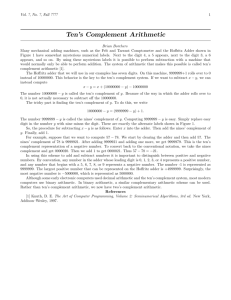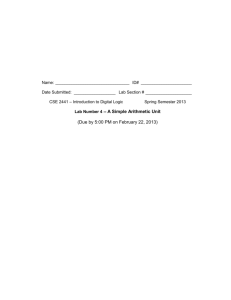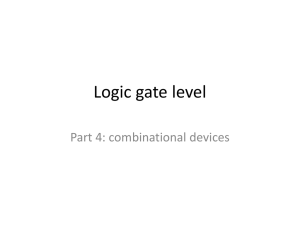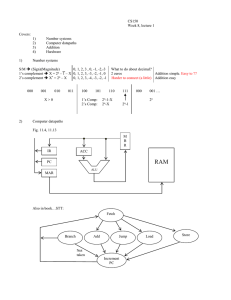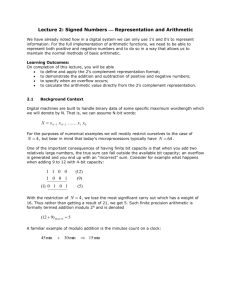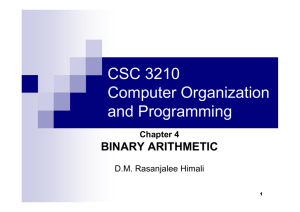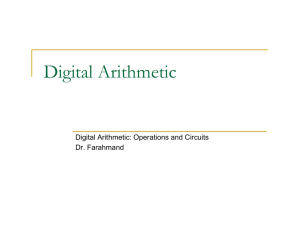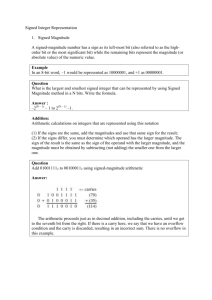ELEC 263 COMPUTER ARCHITECTURE AND ORGANIZATION
advertisement
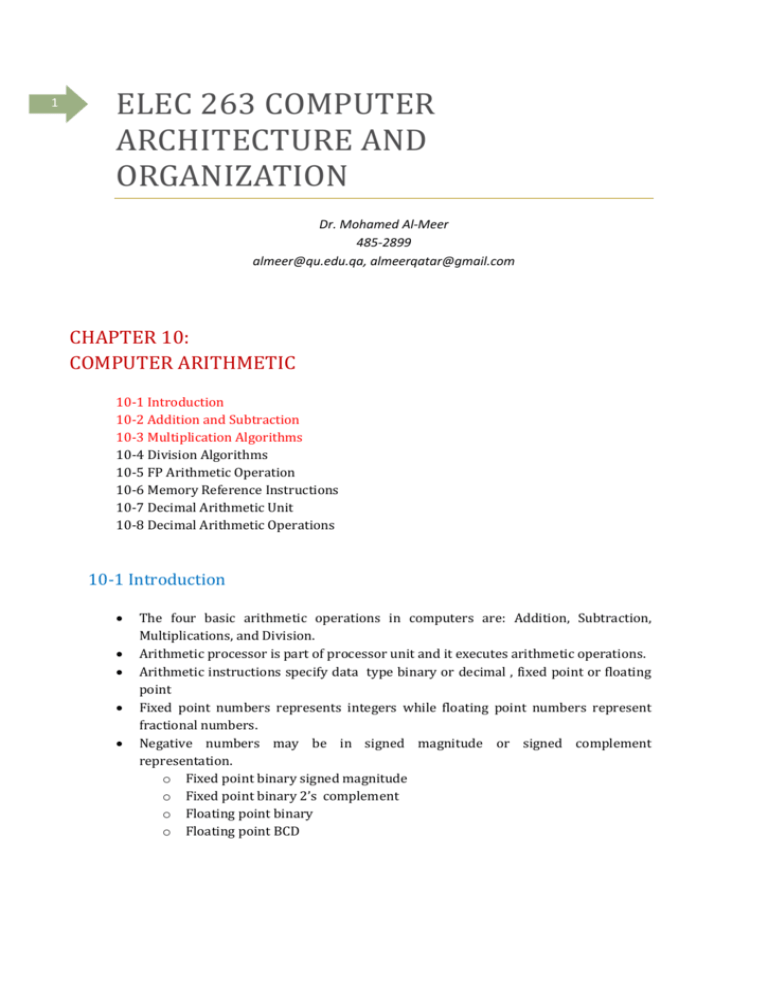
1 ELEC 263 COMPUTER ARCHITECTURE AND ORGANIZATION Dr. Mohamed Al-Meer 485-2899 almeer@qu.edu.qa, almeerqatar@gmail.com CHAPTER 10: COMPUTER ARITHMETIC 10-1 Introduction 10-2 Addition and Subtraction 10-3 Multiplication Algorithms 10-4 Division Algorithms 10-5 FP Arithmetic Operation 10-6 Memory Reference Instructions 10-7 Decimal Arithmetic Unit 10-8 Decimal Arithmetic Operations 10-1 Introduction The four basic arithmetic operations in computers are: Addition, Subtraction, Multiplications, and Division. Arithmetic processor is part of processor unit and it executes arithmetic operations. Arithmetic instructions specify data type binary or decimal , fixed point or floating point Fixed point numbers represents integers while floating point numbers represent fractional numbers. Negative numbers may be in signed magnitude or signed complement representation. o Fixed point binary signed magnitude o Fixed point binary 2’s complement o Floating point binary o Floating point BCD 2 10-2 Addition and Subtraction 1. Signed magnitude Is familiar as used in every day arithmetic calculations We designate magnitudes of two numbers as A and B. when those sign numbers are added we have eight different conditions depending on the sign bits and operations performed. Next table shows those conditions and other columns shows operations performed. Addition (Subtraction) Algorithm will be as o When A and B have identical (different) signs, add the two magnitudes and attaché sign of A to result o When signs of A and B are different (same), subtract smaller number from larger number. Choose sign of result as sign of A if A>B, or complement of sign of A if A<B. o If two magnitudes are equal, subtract B from A and make sign of result positive. Hardware Implementation The two numbers are stored in registers A and B and their signs in flip-flops As and Bs. Result is transferred to A register with its sign Next figure the hardware of signed magnitude addition-subtraction. Consists of registers A and B, sign bits As and Bs Complementer can pass value of B or invert of B according to value of M (implemented with EX-OR). AVF holds overflow bit when A and B are added. The addition of A and B will be through parallel adder. 3 When M=0, B is transferred to adder with A and output in A = A + B. while M=1 complement of B plus carry=1 is transferred to adder with A and output A = A – B. The algorithm is shown in next figure o The two signs As and Bs are compared by EX-OR them. If result is 0 then As = Bs and if result is 1 the As ≠ Bs. o For add operations if have same sign bits the magnitude must be added. For subtract operations different sign bits means magnitudes be added as well. o E bit is carry bit after addition and moves to AVE overflow bit only at this state. o If sign bits are different in add operations or the same in subtract operations the two magnitudes will be subtracted A – B. No overflow can occur here. o After subtract if E=1 this means A>B and if E=0 then A<B. then here it is necessary to get 2’s complement of A (by invert A then add 1) and sign of A is inverted only in this case. o Final result will be in A and its sign in As. 4 2. Signed 2’s complement The left most bit in 2’s complement represented binary number is the sign bit. If 0 the number is positive and if 1 then number is negative. If sign bit is 1 the entire number is represented in 2’s complement. The addition of two numbers represented in 2’s complement is carried out by normal binary addition with carry discarded. The subtraction is carried out by taking 2’s complement (B) of subtrahend and adding it to minuend (A). Overflow can be detected by inspecting last 2 carries out of addition by EX-OR them. If different then overflow is detected. For addition simply implement add then see overflow. For subtract add 2’s complement of B to A and watch overflow since the A and –B could be of same sign. 5 10-3 Multiplication Algorithms The multiplication of two numbers in signed magnitude representation is carried out by successive shift and adds. Look at successive bits of multiplier (least significant bit first), if bit=1 multiplicand is copied else if bit=0, zero is copied down shifted one bit to left from previous copies. Finally all numbers are added and their sum forms the product. Hardware Implementation 6 It is necessary to supply adder for summation two binary numbers and successively accumulate the partial products in a register. Instead of shifting multiplicand to the left the partial product is shifted to the right. When corresponding bit of multiplier is 0 no need to add zeros to partial product, just do nothing. Hardware for multiplication consist of complementer and parallel adder, Registers A and B with their sign bits As and Bs, multiplier Q register, and its sign in Qs. SC is set to number of bits in multiplier and when reaches zero it means partial addition has finished and product is ready in A. Multiplicand in A register while multiplier in Q register initially. The sum of A and B is the partial product in EA. A and Q registers are shifted together giving rise to new bit from Q in Qn bit which tells us if that bit is 0 or 1. Algorithm Signs of Qs and Bs are compared then As and Qs are set as sign of the product. A and E bit are cleared with SC set to number of bits in Q Low order bit in Q is tested. If Qn=1 then B is added to A. if Qn=0 then nothing is done. Registers EAQ are shifted to the right. SC is decremented. Process stops when SC=0. Note that product is occupying A and Q registers and after each shift it replaces A and Q registers. 7



